When I walk into most homes these days, I see two types of spaces, simple white rooms with clean lines or colorful ones filled with pattern and texture.
But what if, like me, you want both? You want calm and creativity. That’s where modern bohemian interior design comes in.
It mixes the easy, natural feel of boho with the clean look of modern style.
In this blog, I’ll explain what modern boho design is, how it differs from traditional boho, its key elements, and ideas to create a cozy, stylish, personal modern boho living room.
What is Modern Bohemian Interior Design?
Modern bohemian design is a blend. It’s not traditional boho with its maximalist vibe and every surface covered. Instead, it pulls back a bit.
You still get the warmth. The texture. The handmade touches. But now there’s space to breathe. Clean lines balance out the pattern. Neutral tones ground the color.
Here’s what makes it work:
- Natural textures like rattan, jute, linen, and wood.
- Warm, earthy colors, think terracotta, cream, olive, and rust.
- Layered textiles such as throws, rugs, and cushions.
- Plants that bring life into every corner.
- Handcrafted pieces that tell a story.
Then vs. Now
Old-school boho was all about more. More color. More pattern. More stuff. Modern boho says less. It keeps the soul but clears the clutter.
You might have one bold rug instead of three. A single statement plant instead of a jungle. It’s boho that grew up a little.
Core Elements of Modern Bohemian Style
Let’s break down what actually makes a space feel modern boho.
- Color Palette: Start with a neutral base, such as cream, beige, or a soft gray. Add warmth with earthy tones. Throw in a jewel tone here and there. Keep it simple.
- Textures: This is where modern boho really shines. Mix smooth with rough. Soft with structure. Try linen curtains with chunky jute rugs. Texture adds depth without adding noise.
- Furniture: Look for timeless pieces. Mid-century modern chairs and vintage thrift finds work well. Keep shapes simple with low tables and clean-lined sofas. Don’t match everything perfectly.
- Lighting: Warm lighting changes everything. Skip harsh overhead lights. Go for woven pendant lamps or floor lamps with linen shades. Natural light is your best friend here.
- Décor: This is where you show who you are. Hang global-inspired art and display handmade ceramics. But edit as you go. Choose pieces that mean something to you.
- Plants: If there’s one rule in modern boho design, add plants. Big leafy ones in corners. Hanging plants near windows. Small succulents on shelves. They make spaces feel grounded.
Modern Boho Living Room Ideas
1. Rattan Revival

My friend Sarah completely changed her living room last spring by adding a curved rattan chair from a local thrift store. “It completely changed the feel of the space,” she told me over coffee.
The natural material brought warmth without overwhelming her small apartment. Rattan furniture works because it’s lightweight and breathable, making rooms feel open rather than cluttered.
The woven texture adds visual interest while staying neutral enough to pair with almost any color scheme.
How to Style It:
- Start with one statement piece, like a rattan chair or headboard
- Mix rattan with soft textiles to balance the harder texture
- Look for secondhand pieces at estate sales for unique finds
- Keep rattan away from direct sunlight to prevent drying and cracking
2. Earthy Neutrals
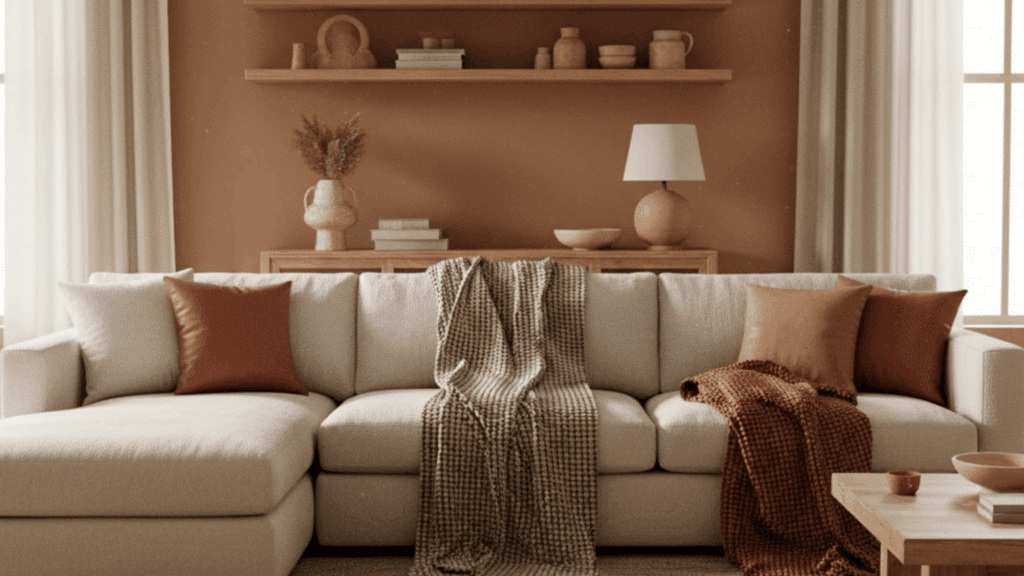
The color palette in my neighbor Tom’s apartment proves that beige doesn’t have to be boring. He layered terracotta, cream, and warm taupe throughout his space, creating a calm foundation that feels grounded.
These tones work together because they’re all pulled from nature, think desert sand, clay pots, and tree bark. The room feels cohesive without being monotonous, and he can easily swap in colorful accents when the mood strikes.
How to Style It:
- Use paint samples on your walls to see how natural light affects each shade
- Combine at least three neutral tones to add depth
- Add texture through linen, wool, or cotton in similar colors
- Include one darker neutral like chocolate brown to anchor the space
3. Layered Rugs

Walking into designer Sofia Martinez’s living room, you’ll notice rugs stacked on rugs, a jute base with a smaller vintage Persian on top.
This technique adds dimension and makes the space feel collected over time rather than decorated all at once. The bottom layer provides coverage while the top rug brings pattern and color.
It’s practical too, since you can change the top rug seasonally without replacing the larger investment piece underneath.
How to Style It:
- Place a larger, neutral rug as your base layer
- Add a smaller patterned or textured rug on top, slightly offset
- Make sure the top rug is at least 2 feet smaller on each side
- Use a rug pad between layers to prevent slipping
4. Greenery Galore

My sister Kate fills every corner of her studio with plants, fiddle leaf figs, pothos trailing from shelves, and a monstera that’s nearly touching her ceiling. “They make the air feel cleaner and the space feel alive,” she says.
Real plants do require care, but even low-maintenance varieties like snake plants or ZZ plants can soften hard edges and bring organic shapes into a room.
The varying heights create visual layers that draw your eye around the space.
How to Style It:
- Group plants in odd numbers for a natural look
- Use plant stands at different heights to create levels
- Choose pots in clay or ceramic to match the boho vibe
- Research light requirements before buying to ensure plants will thrive
5. Vintage Finds
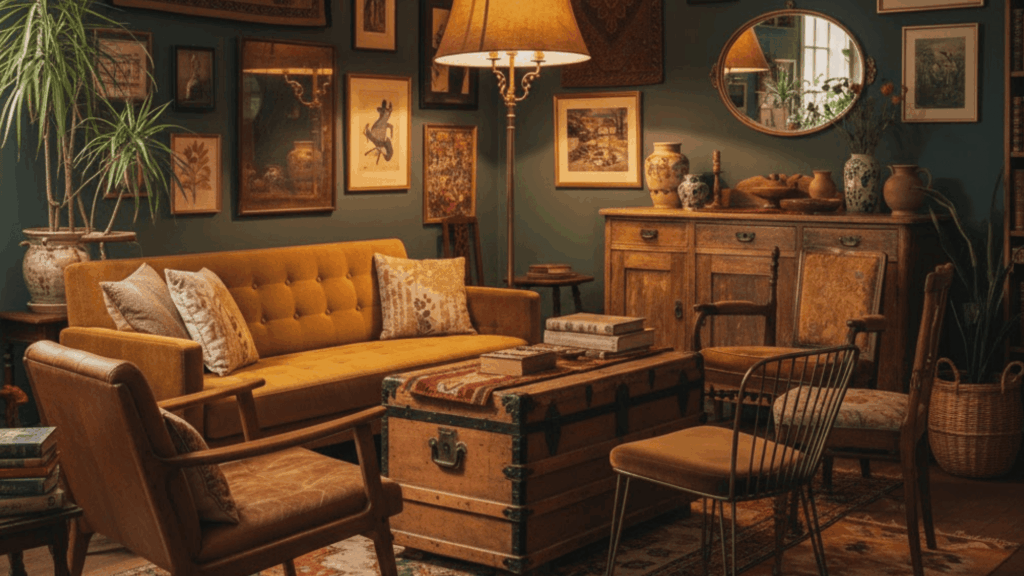
There’s a 1970s brass floor lamp in my living room that I found at a flea market for twenty dollars. It has more character than anything I could buy new, with slight tarnishing that tells its story.
Vintage pieces anchor boho spaces by bringing history and uniqueness that mass-produced items can’t match.
A wooden trunk, or mismatched dining chairs, all add personality while keeping the room from feeling too coordinated.
How to Style It:
- Visit thrift stores and estate sales regularly for the best selection
- Focus on solid wood furniture that can be refinished if needed
- Don’t worry about matching wood tones—variety adds character
- Check structural integrity before buying, especially for seating
6. Global Accents
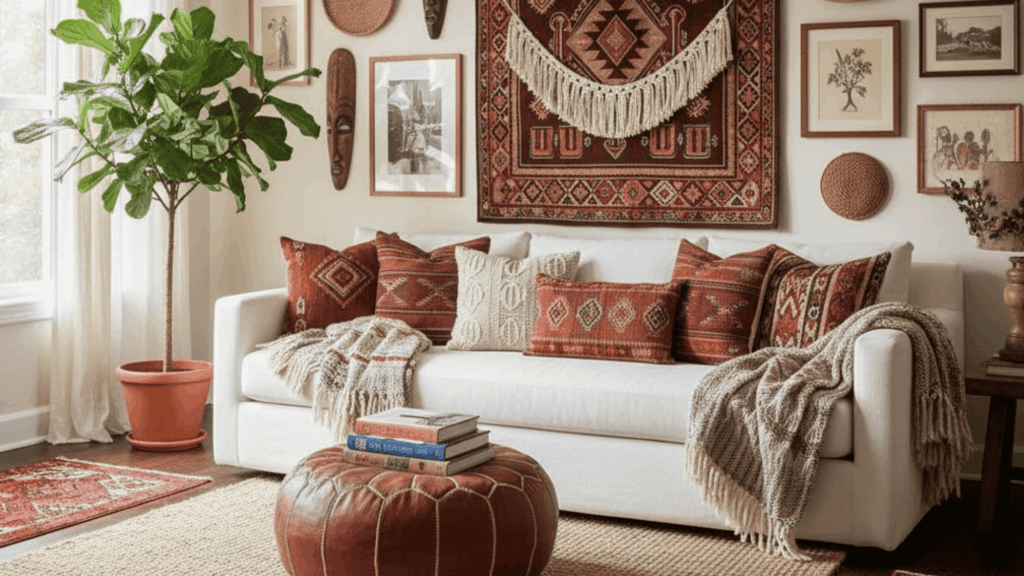
A hand-woven Moroccan pouf sits in designer Olivia Pierce’s living room, paired with Turkish pillows and an Indonesian wall hanging.
These pieces from different cultures share common threads, natural materials, handcrafted details, and rich patterns.
The room feels worldly without trying too hard. Travel souvenirs or marketplace finds tell stories about the places they’re from, making the space feel more personal than any store-bought collection could.
How to Style It:
- Choose pieces from cultures you’ve actually experienced or researched
- Balance busy patterns with solid colors to avoid visual chaos
- Support artisans by buying directly from makers when possible
- Group similar items together rather than scattering them throughout
7. Cozy Floor Seating
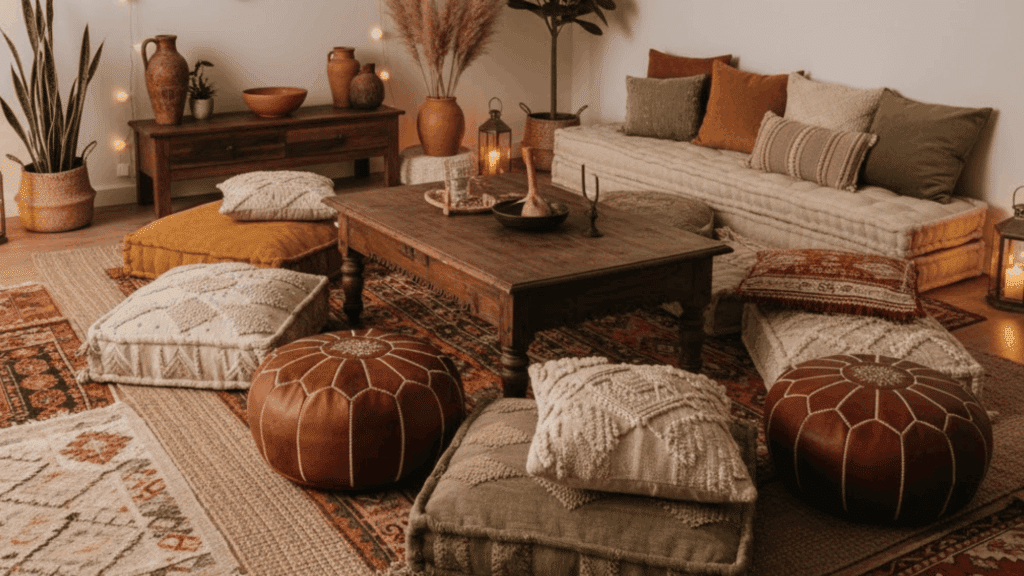
Low cushions and poufs surround the coffee table in interior stylist Nina Caldwell’s meditation corner, creating an intimate gathering spot.
Guests naturally relax when they’re closer to the ground, and the casual setup encourages longer conversations.
Floor seating takes up less visual space than bulky furniture while still providing comfort. It’s perfect for small apartments where traditional sofas might overwhelm the room.
How to Style It:
- Layer floor cushions over a thick rug for added comfort
- Choose cushions with removable, washable covers for easy maintenance
- Add back support with large floor pillows against the wall
- Keep extra seating stored in a basket when not in use
8. Textured Wall Hangings
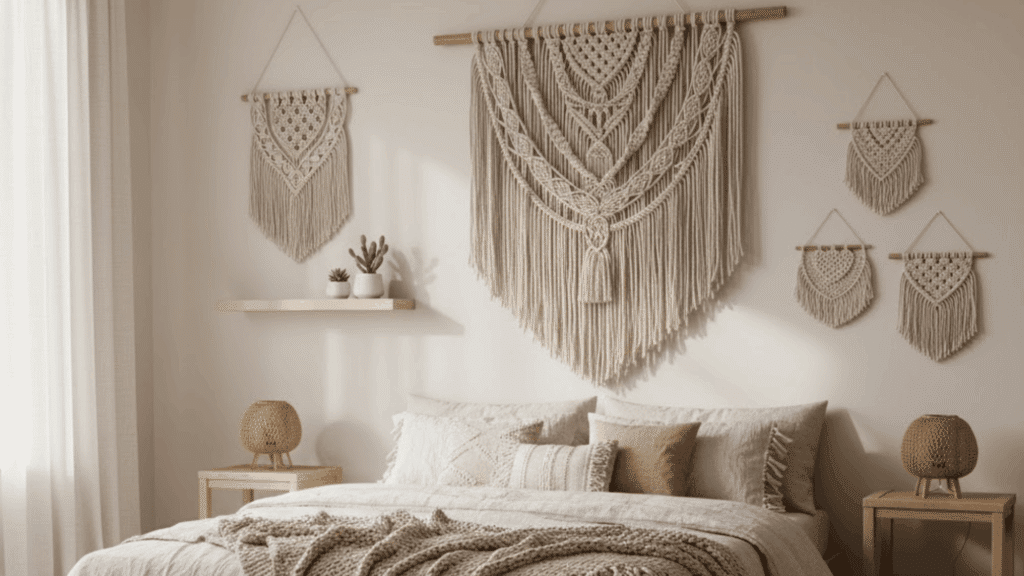
Amber Lewis, one of my colleagues, mounted a large woven wall piece above her bed instead of traditional artwork. The three-dimensional texture catches light differently throughout the day, making the wall feel alive.
Fiber art softens hard surfaces and absorbs sound, which is especially helpful in rooms with high ceilings or lots of hard flooring. These pieces work as functional art that adds warmth without color.
How to Style It:
- Hang wall textiles at eye level for proper visual impact
- Use a wider piece than you think you need to fill the space
- Steam wrinkles out gently rather than ironing directly
- Rotate pieces seasonally to prevent dust buildup in the fibers
9. Patterned Throw Pillows
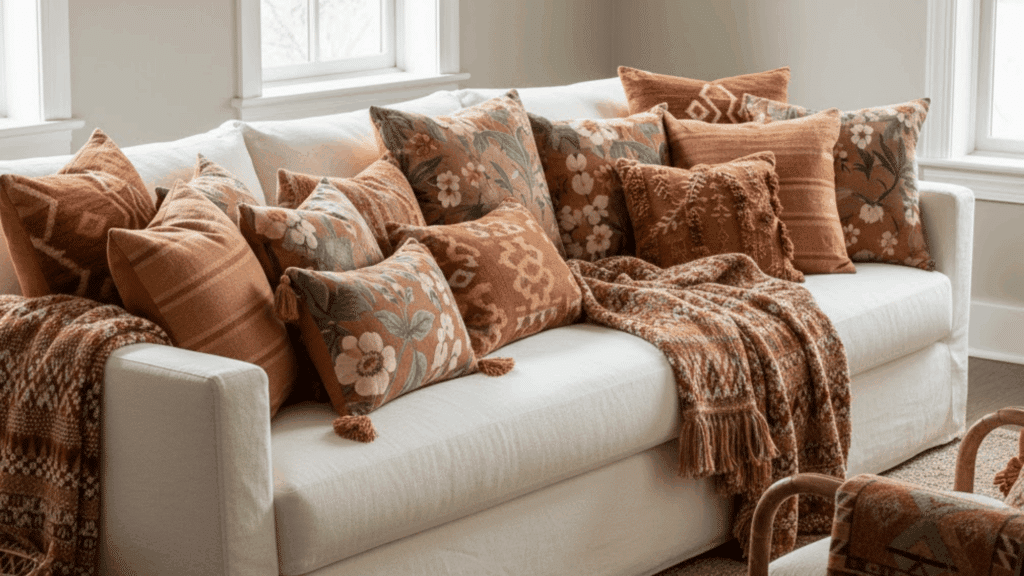
Stylist Claire Bennett mixes geometric prints with floral designs on her sofa while keeping the color palette consistent. “The trick is having a common thread,” she says.
Three to five pillows in varying sizes create interest without overwhelming the seating. The patterns add personality, and the varied textures, velvet, cotton, and linen, make them appealing to use rather than just look at.
How to Style It:
- Stick to three colors maximum across all pillow patterns
- Various sizes from 16 to 24 inches for visual interest
- Place larger pillows in the back, smaller ones in front
- Include at least one solid pillow to give the eye a resting spot
10. Woven Light Fixtures
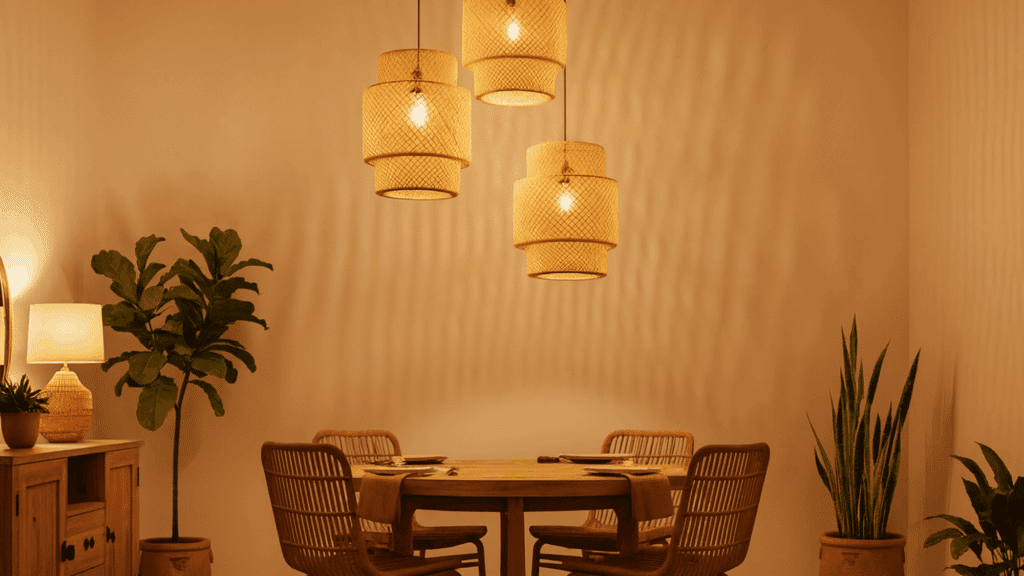
A rattan pendant lamp hangs over my cousin Leanne’s dining table, casting intricate shadows across the walls when lit.
The woven material filters light beautifully, creating warmth without harsh glare. These fixtures become sculptural elements during the day and functional lighting at night.
They work in nearly any room, kitchens, bedrooms, or entryways, bringing organic texture overhead where most people forget to add interest.
How to Style It:
- Install dimmer switches to control the mood and shadow intensity
- Hang pendants 30-36 inches above dining tables for proper scale
- Clean woven fixtures with a soft brush attachment on your vacuum
- Choose the right bulb color; warm white works best with natural materials
11. Natural Wood Furniture
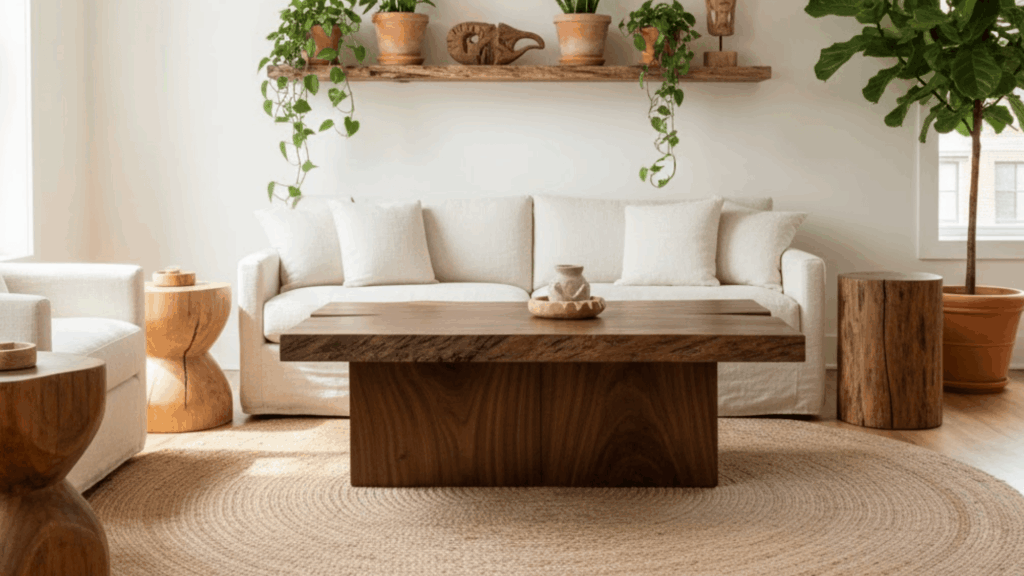
A live-edge coffee table anchors designer Zara Montgomery’s sitting area, with visible knots and grain patterns that make each angle interesting.
The organic edges contrast beautifully with straight-lined sofas and rectangular rugs. Wood brings warmth that painted or metal furniture simply can’t match.
Different wood tones, light oak next to darker walnut, create depth rather than looking mismatched when the rest of the room stays cohesive.
How to Style It:
- Look for FSC-certified wood to ensure responsible sourcing
- Seal raw wood surfaces to protect against water rings and stains
- Embrace imperfections like knots and natural cracks as character
- Mix wood finishes freely but keep metals consistent for balance
12. Handcrafted Ceramics

Pottery teacher Linda keeps a collection of mismatched mugs on open shelving in her kitchen, each one slightly different in glaze and form.
“You can feel the maker’s hands in each piece,” she mentioned during a workshop last fall. Handmade ceramics add a human touch to a space, with slight variations that machine-made items lack.
A ceramic vase or bowl becomes both functional and decorative, especially when left empty to showcase its form.
How to Style It:
- Visit local pottery studios or craft fairs to find unique pieces
- Group ceramics in sets of three or five for visual appeal
- Display pieces where natural light highlights the glaze variations
- Hand-wash delicate items to preserve the finish over time
13. Macramé Touches
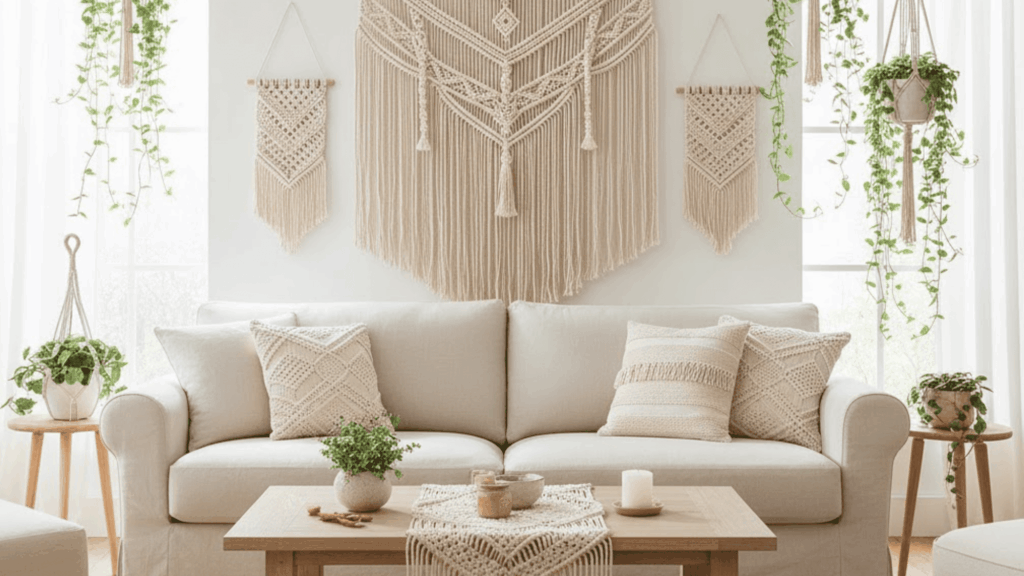
A knotted plant hanger suspends a trailing pothos near the window in stylist Isla Thompson’s sunroom. The cream-colored cord adds vertical interest while taking up zero floor space.
Macramé works because it’s three-dimensional, the knots create shadows and texture that flat wall art can’t achieve.
Even small touches like a macramé table runner or key holder bring that handcrafted, bohemian feel without overwhelming a room.
How to Style It:
- Start small with a single plant hanger before adding larger pieces
- Choose natural cotton cord over synthetic for a genuine texture
- Secure ceiling hooks into studs for heavier hanging planters
- Dust macramé monthly with a soft brush to prevent buildup
14. Minimalist Boho Palette
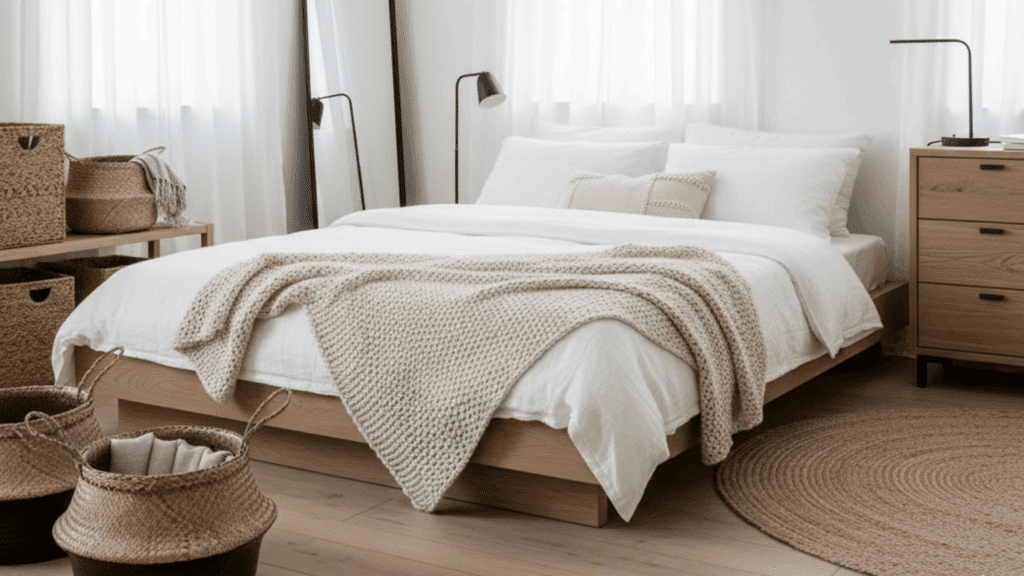
Designer Hannah Wright’s guest room uses only white, black, and natural wood tones. The stripped-back approach lets texture stand out with chunky knit throws, woven baskets, and linen bedding, avoiding busy patterns.
This restrained version of boho feels calmer and more modern while keeping the relaxed, natural vibe. It’s easier to maintain, too, since everything coordinates without much thought.
How to Style It:
- Add warmth through varied textures rather than multiple colors
- Include black accents in small doses for visual grounding
- Use natural materials exclusively to maintain the organic feel
- Let one or two statement pieces stand out against the neutral backdrop
15. Statement Artwork

Last year, I bought an oversized abstract canvas at an art fair, all burnt orange, cream, and deep brown swirls. It was more than I planned to spend, but hanging it above the sofa changed everything.
The painting became the room’s anchor point, and suddenly choosing pillows and throws got easier because I just pulled colors straight from the canvas.
That single piece does more work than the three smaller prints it replaced ever did. Large art commands attention in a way that feels intentional rather than empty.
How to Style It:
- Choose art that’s at least two-thirds the width of your sofa
- Consider original pieces from local artists for unique finds
- Frame prints in simple wood or metal to keep focus on the art
- Hang artwork at 57 inches from the floor to the center, following gallery standards
16. Fringe and Tassel Details
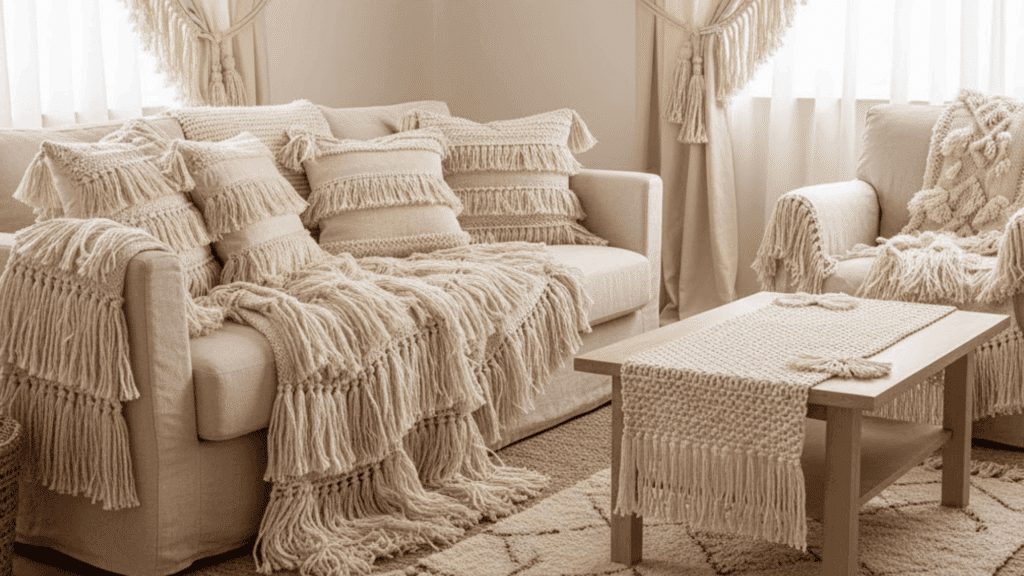
A cream throw blanket draped over the arm of the sofa catches attention not because of its color, but because of the long fringe that sways when you walk past.
Interior designer Mara Steinberg uses these playful details throughout her spaces, tassels on curtain tiebacks, fringe edging on pillows, and knotted pulls on cabinet doors.
These small touches add movement and softness to a room. The texture breaks up flat surfaces and gives the eye something interesting to land on without adding clutter.
How to Style It:
- Add fringe to existing items with fabric glue or simple stitching
- Choose tassel lengths proportional to the item—longer for curtains, shorter for pillows
- Trim uneven fringe with sharp scissors for a cleaner look
- Avoid mixing too many fringe styles in one room to prevent visual confusion
17. Warm Ambient Lighting

Designer Rebecca Chandler layers multiple light sources in every room rather than relying on overhead fixtures.
Table lamps on different surfaces, a floor lamp in the corner, and candles on the coffee table create pools of warm light that make spaces feel inviting after dark.
The varying heights and intensities add dimension, while warm bulbs cast a golden glow that feels more natural than cool white light. Rooms lit this way photograph beautifully and feel comfortable for actual living.
How to Style It:
- Use bulbs between 2700K and 3000K for warm, flattering light
- Place lamps at three different heights throughout the room
- Add dimmer switches to control brightness for different moods
- Keep lamp shades light-colored to diffuse rather than block light
18. Moroccan-Inspired Decor
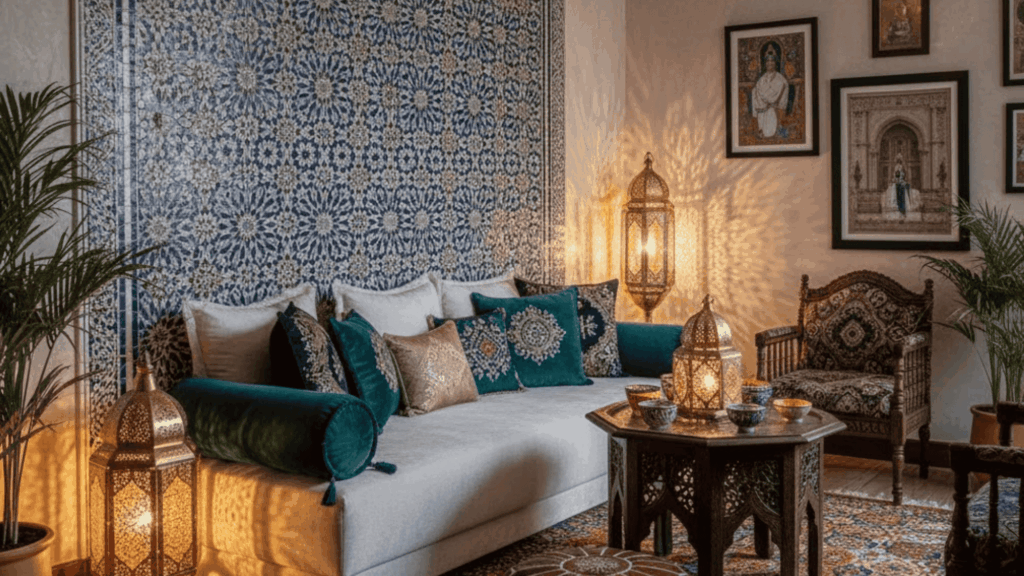
A geometric tile pattern covers the bathroom floor in stylist Diana Rothman’s renovation, featuring deep blue and white in a traditional zellige design.
The intricate pattern brings Old World charm without feeling stuffy. Moroccan elements—poufs, lanterns, patterned textiles- add richness and detail that plain modern pieces often lack.
These designs have survived centuries because they balance complexity with functionality, working in contemporary spaces just as well as traditional ones.
How to Style It:
- Start with one Moroccan element like a pouf or mirror
- Balance intricate patterns with plain walls and simple furniture
- Use brass or copper accents to complement the style
- Layer in textiles with geometric designs for cohesion
19. Boho Glam Elements
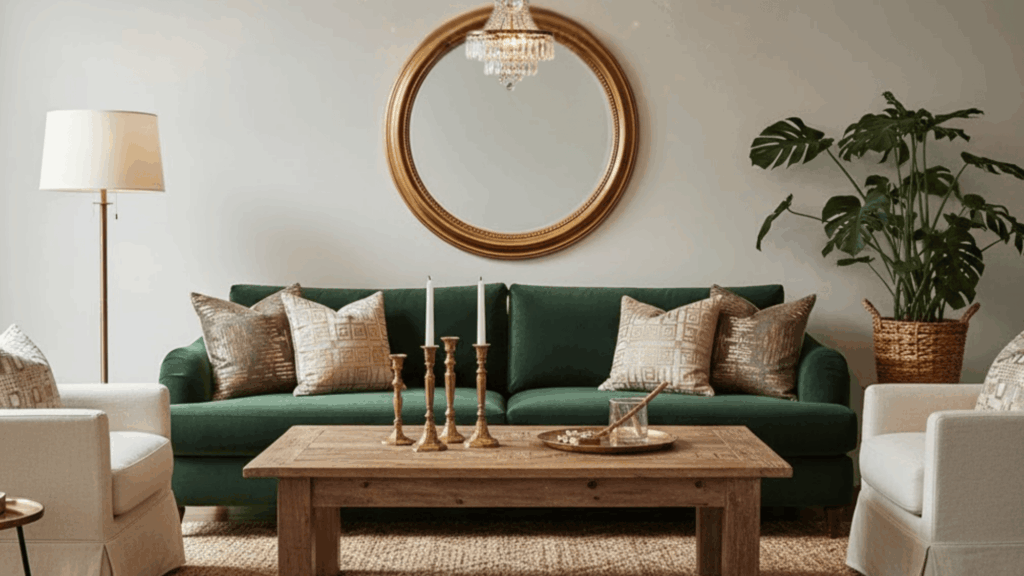
Gold accents appear throughout my colleague Simone’s otherwise earthy living room, a gilded mirror frame, brass candlesticks, and metallic thread in throw pillows.
The shimmer elevates the space from casual to refined without losing its relaxed feel. This contrast between rustic and polished creates tension that keeps rooms interesting.
A velvet cushion next to a jute rug, or a crystal chandelier above a reclaimed wood table, proves that boho doesn’t have to mean rough around the edges.
How to Style It:
- Limit metallic finishes to one type, gold, brass, or copper
- Add shine-through accessories rather than major furniture pieces
- Balance glamorous elements with rougher textures like wood or stone
- Use metallic accents in groups of three for visual impact
20. Mixed Metal Accents

The kitchen in designer Veronica Mills’s home features brass cabinet pulls, copper pendant lights, and a stainless steel fridge. “Matching all your metals feels too coordinated,” she writes in her design guide.
The mix feels collected and personal rather than store-bought. Different finishes catch light in unique ways, adding subtle variation throughout the day.
This approach works especially well in boho spaces where perfection isn’t the goal.
How to Style It:
- Choose one dominant metal and use others as accents
- Keep metals in the same temperature family—warm or cool
- Distribute mixed metals evenly throughout the space
- Avoid more than three different metal finishes in one room
21. Low-Lying Sofas
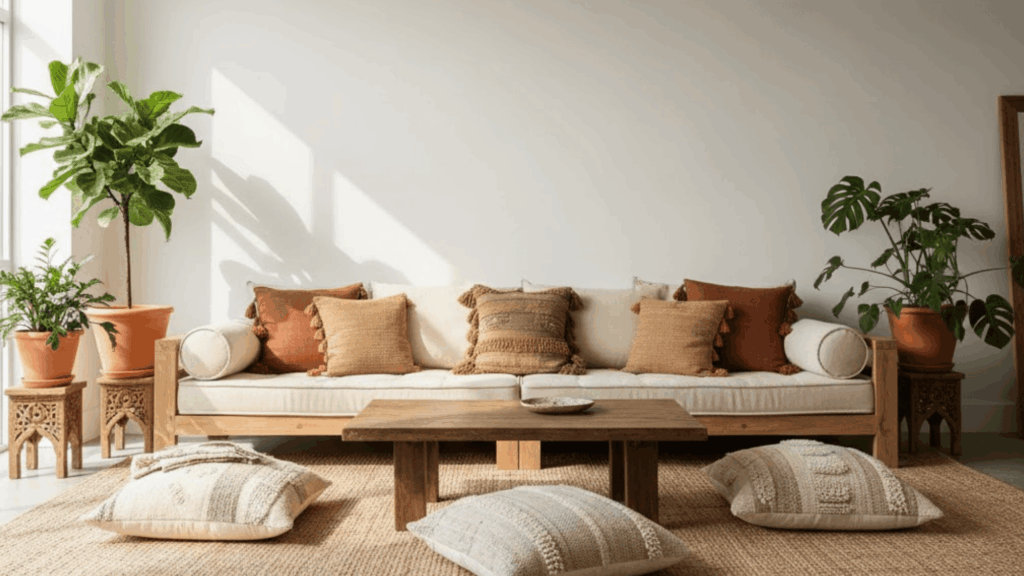
A teak platform sofa sits just inches off the ground in my friend John’s living space, piled with oversized cushions. The low profile makes the ceiling feel higher and the room more spacious.
These pieces encourage a relaxed posture, more lounging than sitting, which suits the laid-back boho aesthetic.
Floor-level furniture also puts you closer to layered rugs and floor plants, creating a grounded feeling that standard-height sofas miss.
How to Style It:
- Add extra cushions for back support on very low seating
- Keep coffee tables proportionally low to match the sofa height
- Consider mobility needs before committing to low furniture
- Use furniture risers if you change your mind later about the height
How to Balance Boho and Modern Aesthetics
Here’s the tricky part. Too much boho and your space feels messy. Too modern and it feels cold. Balance is everything.
- Stick to 3–4 colors: Choose a neutral base and two or three accent colors. When everything works together, the room feels calm, even with pattern and texture. No need for more.
- Limit your patterns: One patterned rug. Maybe a few patterned cushions. But not patterned everything. Let some pieces be solid so your eye has somewhere to rest and relax.
- Use symmetry: Even in a relaxed boho space, symmetry helps. Two matching chairs facing a sofa. A pair of lamps on either side. It keeps things from feeling random.
- For every bold piece, add a grounding neutral: Got a bright orange throw? Pair it with a cream sofa. A busy rug? Keep the furniture simple. This way, nothing fights for attention in the room.
Bohemian Décor Essentials
Not sure where to start? Here’s a simple checklist.
| Item | Why You Need It |
|---|---|
| Rattan or wicker chair | Adds texture and that classic boho feel |
| Macramé wall hanging | Just one, not five |
| Patterned area rug | Look for Moroccan or vintage styles |
| Pouf or floor cushion | Great for extra seating |
| Throw blankets | Layer two or three in different textures |
| Plants in woven baskets | Snake plants and pothos are easy to care for |
| Handmade ceramics | Vases, bowls, or planters |
| Wood coffee table | Something with natural grain |
Where to find them
You don’t need to spend a lot. Thrift stores and flea markets are gold mines for vintage finds. Etsy has tons of handmade pieces. Check out local artisans for one-of-a-kind ceramics or textiles.
And if you’re crafty, try a DIY project. Paint a plain vase. Make your own woven wall art. Turn old fabric into cushion covers.
Global Influences in Bohemian Design
Boho style has always pulled from different cultures. That’s part of what makes it interesting. But it’s important to do this with respect.
- Moroccan: Think lanterns, patterned rugs, and metal trays. These pieces add warmth and history.
- Mexican: Bold colors, handcrafted pottery, and woven textiles. Look for pieces made by local artisans.
- Indian: Block-printed fabrics, carved wood furniture, and brass accents. These bring richness without feeling heavy.
When you buy from real makers, you’re supporting their craft. And your space feels more authentic.
Final Thoughts
Modern bohemian design, to me, is all about comfort and creativity living side by side. I love how it mixes clean, modern lines with cozy, collected details that tell a story.
The best part? There are no strict rules, just balance, warmth, and personality. Even if it’s a rattan chair, a layered rug, or a plant-filled corner, each piece adds a bit of soul.
Start small, trust your taste, and let your home change naturally over time.
If you’re ready to give your space that modern boho charm, pick one idea from this guide and try it today. Your perfect cozy-meets-chic home is waiting!














